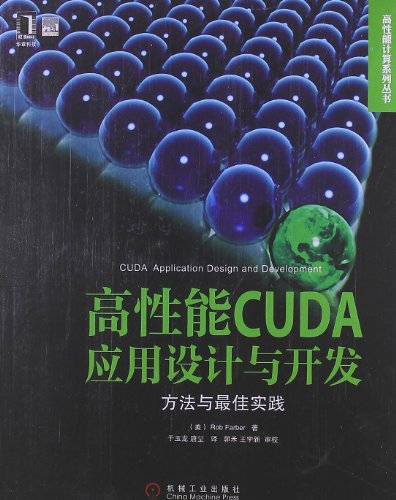MEI ROB FARBER (1 resultados)
Tipo de artículo
- Todo tipo de artículos
- Libros (1)
- Revistas y publicaciones
- Cómics
- Partituras
- Arte, grabados y pósters
- Fotografías
- Mapas
-
Manuscritos y
coleccionismo de papel
Condición
- Todo
- Nuevos
- Antiguos o usados
Encuadernación
- Todo
- Tapa dura
- Tapa blanda
Más atributos
- Primera edición
- Firmado
- Sobrecubierta
- Con imágenes del vendedor
- Sin impresión bajo demanda
Ubicación del vendedor
Valoración de los vendedores
-
High-performance the CUDA application design and development: methods and best practices(Chinese Edition)
Publicado por Machinery Industry Press, 2013
ISBN 10: 7111404467ISBN 13: 9787111404460
Librería: liu xing, Nanjing JiangSu, JS, China
Libro
paperback. Condición: New. Ship out in 2 business day, And Fast shipping, Free Tracking number will be provided after the shipment.Paperback. Pub Date: 2013 Pages: 292 Language: Chinese in Publisher: China Machine Press high performance CUDA applications design and development: methods and best practices is widely recognized as the systematic study of the development and design of high-performance CUDA applications The classics. years of work experience of U.S. national security laboratory experienced high-performance programming experts crystals. senior expert of the Oak Ridge National Laboratory strongly recommended! Not only from a hardware point of view. the book in-depth interpretation of the design philosophy of CUDA and GPGPU hardware architecture. CUDA applications design and development of thinking and explain from a software point of view. the methods. techniques. guidelines. considerations and best practices. Chapter 1 first introduces the the CUDA core concepts and programming ideas. as well as build the tools and methods needed to debug CUDA applications. and then explain a the CPU programming guidelines for effectively improve program performance; Chapter 2 explained CUDA in machine learning and optimization the core concepts and applications. and gives a complete generic framework; Chapter 3 describes the the CUDA performance analysis tool suite as well as performance analysis method. PCA and NLPCA data mining method; explain in Chapter 4 CUDA execution model. profoundly reveals the work and principles of the GPU; Chapter 5 describes the CUDA provides a variety of GPU memory. as well as the advantages and disadvantages of the various memory; Chapter 6 to explain the efficient use of memory technology; Chapter 7 GPU to provide a variety of parallel applications; Chapter 8 first discusses a variety of the CUDA backend equipment. and CUDA Python. Java. R high-level language to interact; Chapter 9 explain the the CUDA graphics rendering mixed programming; Chapter 10 explain the methods and technical details of cloud computing and cluster environments using CUDA; Chapter 11 introduces the CUDA processing in high-dimensional data. the real problem of the force directed graph. interactive workflow quantum chemistry applications; Chapter 12 to learn CUDA design a comprehensive application for real-time video streaming cases. Contents: Translator foreword Foreword Preface Chapter 1 the CUDA Getting started with programming ideas 1.1 source code and Wiki 1.2 a for the difference between CUDA and traditional application development example 1.3 to select the appropriate CUDA API1.4 CUDA some basic concepts 1.5 understand the first Runtime Kernel1.6 GPGPU programming three rules 1.6.1 Rule 1: the data into the always stored in GPU1.6.2 Rule 2: Leave it to GPGPU enough task 1.6.3 Principle 3: focus on reuse data on GPGPU to avoid ideas and data transmission bandwidth limit of 1.7 big O notation 1.8 CUDA and Amdahl's Law 1.9 data parallel and task parallel 1.10 hybrid execution: using both the CPU and GPU resources 1.11 regression testing and correctness 1.12 silent error 1.13 1.14 UNIX debugging Profile. debug method 1.14. 1 NVIDIA cuda-gdb debugger 1.14.2 CUDA memory checker 1.14.3 used by UNIX ddd interface the cuda-gdb1.15 use Parallel Nsight 1.16 Chapter Summary Chapter 2 CUDA in machine learning and optimization application debugging Windows 2.1 build mode with analog 2.1.1 2.1.2 Nelder-Mead method of fitting a parametric model 2.1.3 Levenberg-Marquardt method 2.1.4 algorithm accelerated 2.2 machine learning and neural networks 2.3 XOR logic: a nonlinear machine learning problem 2.3.1 The objective function example 2.3.2 Discussion 2.6 Chapter Summary 2.7 C + + NELDER 2.5 performance optimization for a brief discussion of the code 2.4 XOR logic performance results for the multi-GPU devices. a complete multi-CPU processor functor 2.3.3 complete Nelder-Mead Chapter 3 of the Code Templates-MEAD CUDA toolkit: the PCA. NLPCA performance analysis 3.1 PC.


